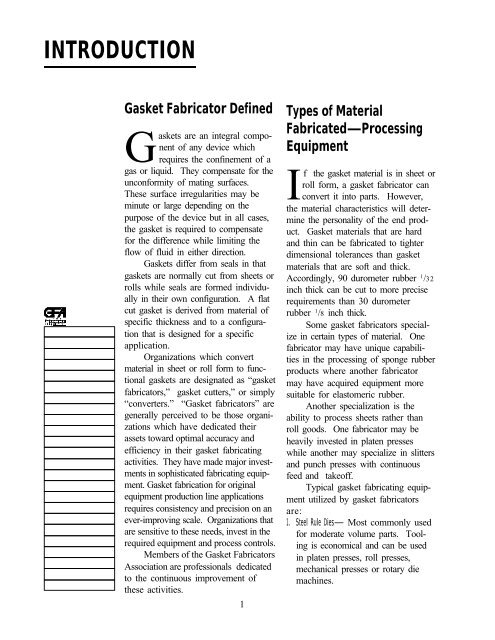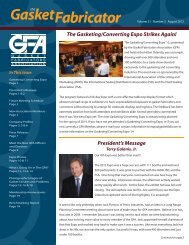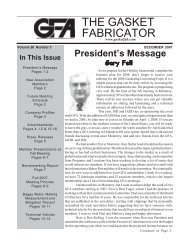Technical Handbook - Gasket Fabricators Association
Technical Handbook - Gasket Fabricators Association
Technical Handbook - Gasket Fabricators Association
You also want an ePaper? Increase the reach of your titles
YUMPU automatically turns print PDFs into web optimized ePapers that Google loves.
INTRODUCTION<br />
<strong>Gasket</strong> Fabricator Defined<br />
<strong>Gasket</strong>s are an integral component<br />
of any device which<br />
requires the confinement of a<br />
gas or liquid. They compensate for the<br />
unconformity of mating surfaces.<br />
These surface irregularities may be<br />
minute or large depending on the<br />
purpose of the device but in all cases,<br />
the gasket is required to compensate<br />
for the difference while limiting the<br />
flow of fluid in either direction.<br />
<strong>Gasket</strong>s differ from seals in that<br />
gaskets are normally cut from sheets or<br />
rolls while seals are formed individually<br />
in their own configuration. A flat<br />
cut gasket is derived from material of<br />
specific thickness and to a configuration<br />
that is designed for a specific<br />
application.<br />
Organizations which convert<br />
material in sheet or roll form to functional<br />
gaskets are designated as “gasket<br />
fabricators,” gasket cutters,” or simply<br />
“converters.” “<strong>Gasket</strong> fabricators” are<br />
generally perceived to be those organizations<br />
which have dedicated their<br />
assets toward optimal accuracy and<br />
efficiency in their gasket fabricating<br />
activities. They have made major investments<br />
in sophisticated fabricating equipment.<br />
<strong>Gasket</strong> fabrication for original<br />
equipment production line applications<br />
requires consistency and precision on an<br />
ever-improving scale. Organizations that<br />
are sensitive to these needs, invest in the<br />
required equipment and process controls.<br />
Members of the <strong>Gasket</strong> <strong>Fabricators</strong><br />
<strong>Association</strong> are professionals dedicated<br />
to the continuous improvement of<br />
these activities.<br />
1<br />
Types of Material<br />
Fabricated—Processing<br />
Equipment<br />
If the gasket material is in sheet or<br />
roll form, a gasket fabricator can<br />
convert it into parts. However,<br />
the material characteristics will determine<br />
the personality of the end product.<br />
<strong>Gasket</strong> materials that are hard<br />
and thin can be fabricated to tighter<br />
dimensional tolerances than gasket<br />
materials that are soft and thick.<br />
Accordingly, 90 durometer rubber 1 /32<br />
inch thick can be cut to more precise<br />
requirements than 30 durometer<br />
rubber 1 /8 inch thick.<br />
Some gasket fabricators specialize<br />
in certain types of material. One<br />
fabricator may have unique capabilities<br />
in the processing of sponge rubber<br />
products where another fabricator<br />
may have acquired equipment more<br />
suitable for elastomeric rubber.<br />
Another specialization is the<br />
ability to process sheets rather than<br />
roll goods. One fabricator may be<br />
heavily invested in platen presses<br />
while another may specialize in slitters<br />
and punch presses with continuous<br />
feed and takeoff.<br />
Typical gasket fabricating equipment<br />
utilized by gasket fabricators<br />
are:<br />
1. Steel Rule Dies— Most commonly used<br />
for moderate volume parts. Tooling<br />
is economical and can be used<br />
in platen presses, roll presses,<br />
mechanical presses or rotary die<br />
machines.







